Unconfined Compressive Strength of Cement-Stabilized Qiantang River Silty Clay
Abstract
1. Introduction
2. Experimental Program
2.1. Testing Materials
2.2. Testing Procedures
2.3. Testing Scheme
3. Test Results
3.1. Effects of the Mixing Ratio on UCS
3.2. Effects of Curing Duration on UCS
3.3. Prediction of UCS of the Cement-Stabilized Qiantang River Silty Clay
4. Discussion
5. Conclusions
- The UCS of the cement-stabilized Qian-tang River silty clay increases with increasing cement content and decreases with increasing mixing-water content, under otherwise similar conditions.
- For a given curing duration, the UCS of the cement-stabilized Qian-tang River silty clay decreases with increasing water-to-cement ratio uniquely, regardless of mixing-water content and cement content. For each of the curing times, UCS increases by around five times when the water-to-cement ratio reduces from 2.1 to 0.875.
- There appears to be a unified UCS-w/c correlation for a given curing duration, through an analysis of several cement-stabilized clays. All data points fall into a band confined by 2 times and 0.5 times the average trend.
- A prediction method of UCS is proposed by considering the water-to-cement ratio and curing time for the Qian-tang River silty clay.
- The experimental data of the present study suggested that using the method recommended by the technical standard in China to predict the UCS may overestimate the strength cured for 90 days, which is the design value for an engineering project.
Author Contributions
Funding
Data Availability Statement
Conflicts of Interest
References
- Bell, F.G. Engineering Treatment of Soil; E & FN Spon: London, UK, 1993. [Google Scholar]
- Bergado, D.T.; Anderson, L.R.; Miura, N.; Balasubramaniam, A.S. Soft Ground Improvement in Lowland and Other Environments; ASCE: New York, NY, USA, 1996. [Google Scholar]
- Consoli, N.C.; Rosa, F.D.; Fonini, A. Plate load tests on cemented soil layers overlaying weaker soil. J. Geotech. Geoenvironmental Eng. 2009, 135, 1846–1856. [Google Scholar] [CrossRef]
- Chew, S.H.; Kamruzzaman, A.H.M.; Lee, F.H. Physicochemical and engineering behavior of cement treated clays. J. Geotech. Geoenvironmental Eng. 2004, 130, 696–706. [Google Scholar] [CrossRef]
- Horpibulsuk, S.; Miura, N.; Nagaraj, T.S. Assessment of strength development in cement-admixed high water content clays with Abrams’ law as a basis. Géotechnique 2003, 53, 439–444. [Google Scholar] [CrossRef]
- Lee, F.-H.; Lee, Y.; Chew, S.-H.; Yong, K.-Y. Strength and modulus of marine clay-cement mixes. J. Geotech. Geoenvironmental Eng. 2005, 131, 178–186. [Google Scholar] [CrossRef]
- Lorenzo, G.A.; Bergado, D.T. Fundamental parameters of cement-admixed clay—New approach. J. Geotech. Geoenvironmental Eng. 2004, 130, 1042–1050. [Google Scholar] [CrossRef]
- Uddin, K. Strength and Deformation Behaviour of Cement Treated Bangkok Clay; Asian Institute of Technology: Bangkok, Thailand, 1994. [Google Scholar]
- Zhang, Z.; Omine, K.; Flemmy, S.O.; Li, C. The Liquid Limit as a Factor in Assessing the Improvement of Stabilized Cement-Based Highwater Content Clayey Sediments. Materials 2022, 15, 7240. [Google Scholar] [CrossRef]
- Tan, T.-S.; Goh, T.-L.; Yong, K.-Y. Properties of Singapore marine clays improved by cement mixing. Geotech. Test. J. 2002, 25, 422–433. [Google Scholar] [CrossRef]
- Miura, N.; Horpibulsuk, S.; Nagaraj, T. Engineering behavior of cement stabilized clay at high water content. Soils Found. 2001, 41, 33–45. [Google Scholar] [CrossRef]
- Horpibulsuk, S.; Katkan, W.; Sirilerdwattana, W.; Rachan, R. Strength development in cement stabilized low plasticity and coarse grained soils: Laboratory and field study. Soils Found. 2006, 46, 351–366. [Google Scholar] [CrossRef]
- Horpibulsuk, S.K.; Rachan, R.L.; Chinkulkijniwat, A.; Raksachon, Y.; Suddeepong, A. Analysis of strength development in cement-stabilized silty clay from microstructural considerations. Constr. Build. Mater. 2010, 24, 2011–2021. [Google Scholar] [CrossRef]
- Chian, S.C.; Nguyen, S.T.; Phoon, K.K. Extended strength development model of cement-treated clay. J. Geotech. Geoenvironmental Eng. 2016, 142, 6015014. [Google Scholar] [CrossRef]
- Chian, S.C.; Chim, Y.Q.; Wong, J.W. Influence of sand impurities in cement-treated clays. Géotechnique 2017, 67, 31–41. [Google Scholar] [CrossRef]
- Lorenzo, G.A.; Bergado, D.T. Fundamental characteristics of cement-admixed clay in deep mixing. J. Mater. Civ. Eng. 2006, 18, 161–174. [Google Scholar] [CrossRef]
- Consoli, N.C.; Foppa, D.; Festugato, L.; Heineck, K.S. Key parameters for strength control of artificially cemented soils. J. Geotech. Geoenvironmental Eng. 2007, 133, 197–205. [Google Scholar] [CrossRef]
- Consoli, N.C.; Cruz, R.C.; Floss, M.F.; Festugato, L. Parameters Controlling Tensile and Compressive Strength of Artificially Cemented Sand. J. Geotech. Geoenvironmental Eng. 2010, 136, 759–763. [Google Scholar] [CrossRef]
- Consoli, N.C.; Quiñónez, R.A.; González, L.E.; López, R.A. Influence of molding moisture content and porosity/cement index on stiffness, strength, and failure envelopes of artificially cemented fine-grained soils. J. Mater. Civ. Eng. 2017, 29, 4016277. [Google Scholar] [CrossRef]
- Román Martínez, C.; de la Rosa, Y.E.; Estrada Luna, D.; Baldovino, J.A.; Jordi Bruschi, G. Strength, Stiffness, and Microstructure of Stabilized Marine Clay-Crushed Limestone Waste Blends: Insight on Characterization through Porosity-to-Cement Index. Materials 2023, 16, 4983. [Google Scholar] [CrossRef] [PubMed]
- Jongpradist, P.; Youwai, S.; Jaturapitakkul, C. Effective void ratio for assessing the mechanical properties of cement-clay admixtures at high water content. J. Geotech. Geoenvironmental Eng. 2011, 137, 621–627. [Google Scholar] [CrossRef]
- Wu, J.; Liu, L.; Deng, Y.; Zhang, G.; Zhou, A.; Wang, Q. Distinguishing the effects of cementation versus density on the mechanical behavior of cement-based stabilized clays. Constr. Build. Mater. 2021, 271, 121571. [Google Scholar] [CrossRef]
- Yoobanpot, N.; Jamsawang, P.; Horpibulsuk, S. Strength behavior and microstructural characteristics of soft clay stabilized with cement kiln dust and fly ash residue. Appl. Clay Sci. 2017, 141, 146–156. [Google Scholar] [CrossRef]
- Khan, Q.; Subramanian, S.; Wong, D.Y.; Ku, T. Bender elements in stiff cemented clay: Shear wave velocity (Vs) correction by applying wavelength considerations. Can. Geotech. J. 2019, 56, 1034–1041. [Google Scholar] [CrossRef]
- Subramanian, S.; Khan, Q.; Ku, T. Effect of sand on the stiffness characteristics of cement-stabilized clay. Constr. Build. Mater. 2020, 264, 120192. [Google Scholar] [CrossRef]
- Kaniraj, S.R.; Havanagi, V.G. Compressive strength of cement stabilized fly ash-soil mixtures. Cem. Concr. Res. 1999, 29, 673–677. [Google Scholar] [CrossRef]
- Chen, D.; Liao, Y.; Jiang, C.; Feng, X. The mechanical properties of coastal soil treated with cement. J. Wuhan Univ. Technol. Sci. Ed. 2013, 28, 1155–1160. [Google Scholar] [CrossRef]
- JGJ-79-2012; Technical Code for Ground Treatment of Buildings. China Architecture & Building Press: Beijing, China, 2013.
- Kamruzzaman, A.H.M.; Chew, S.H.; Lee, F.H. Microstructure of cement-treated Singapore marine clay. Proc. Inst. Civ. Eng. Ground Improv. 2006, 10, 113–123. [Google Scholar] [CrossRef]
- Chian, S.C.; Bi, J. Influence of grain size gradation of sand impurities on strength behaviour of cement-treated clay. Acta Geotech. 2021, 16, 1127–1145. [Google Scholar] [CrossRef]
- Wei, X.; Liu, H.; Ku, T. Effects of plastic fines content on the engineering properties of cement-stabilized sands. Granul. Matter 2021, 23, 46. [Google Scholar] [CrossRef]
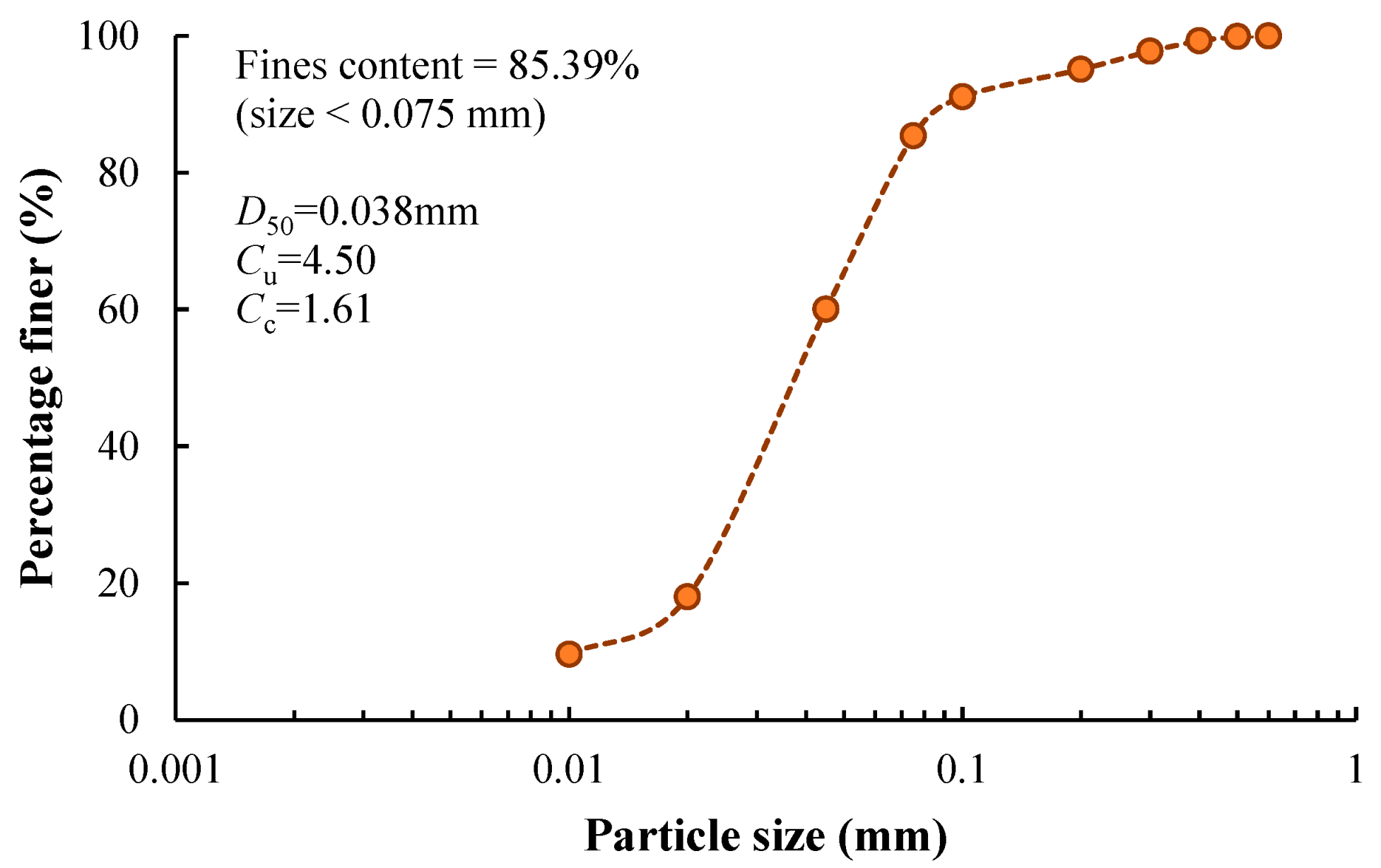
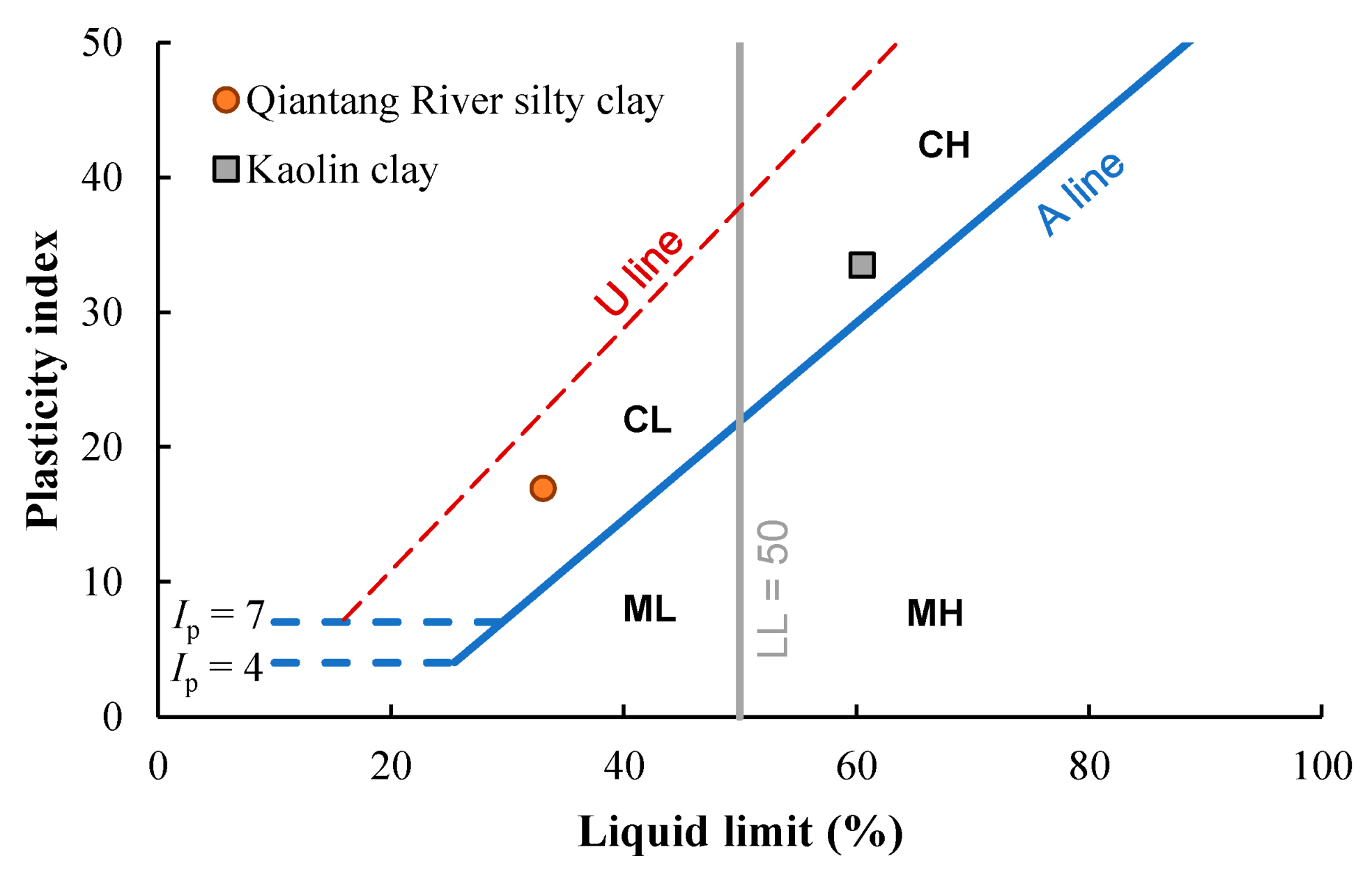
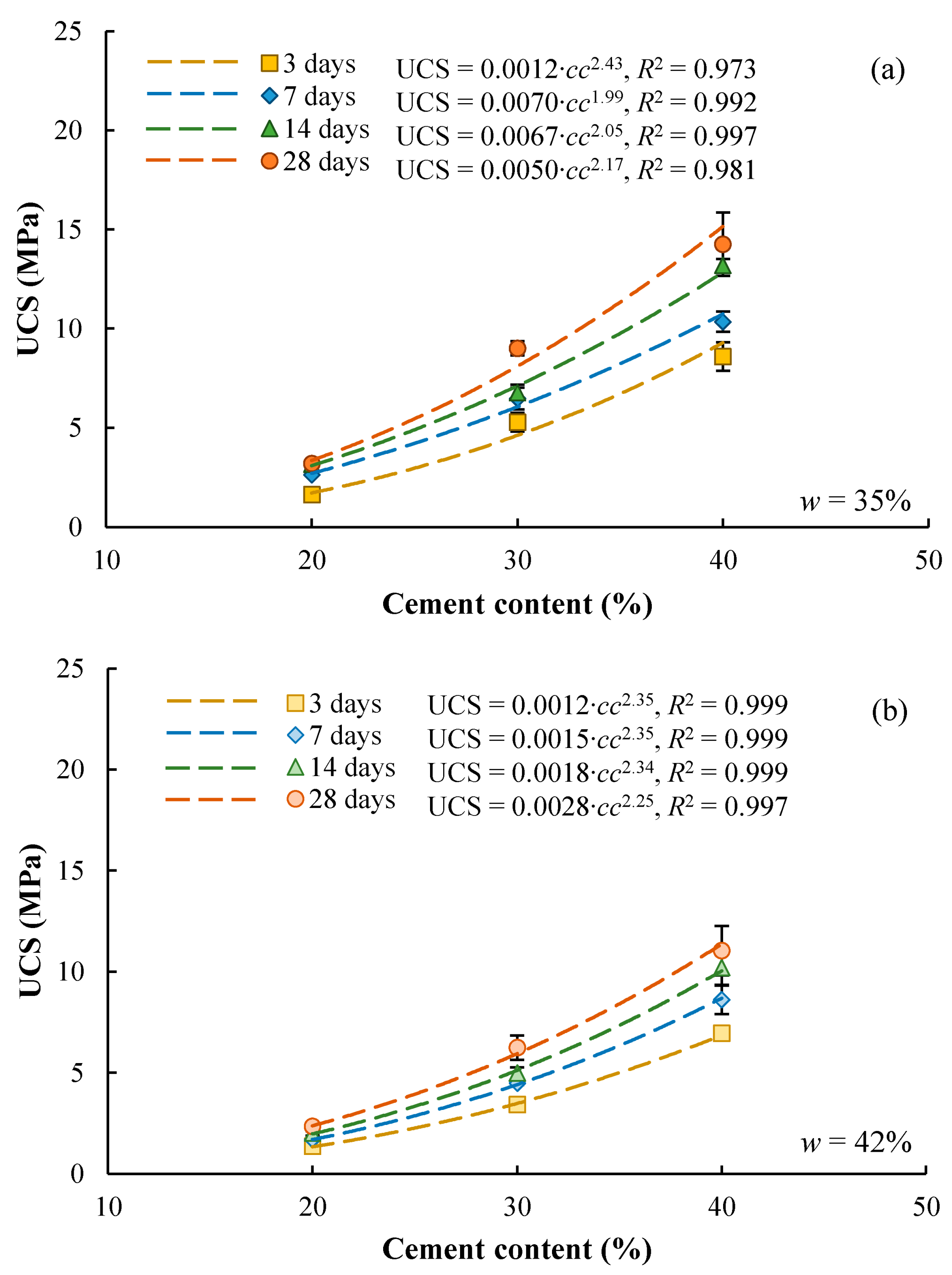
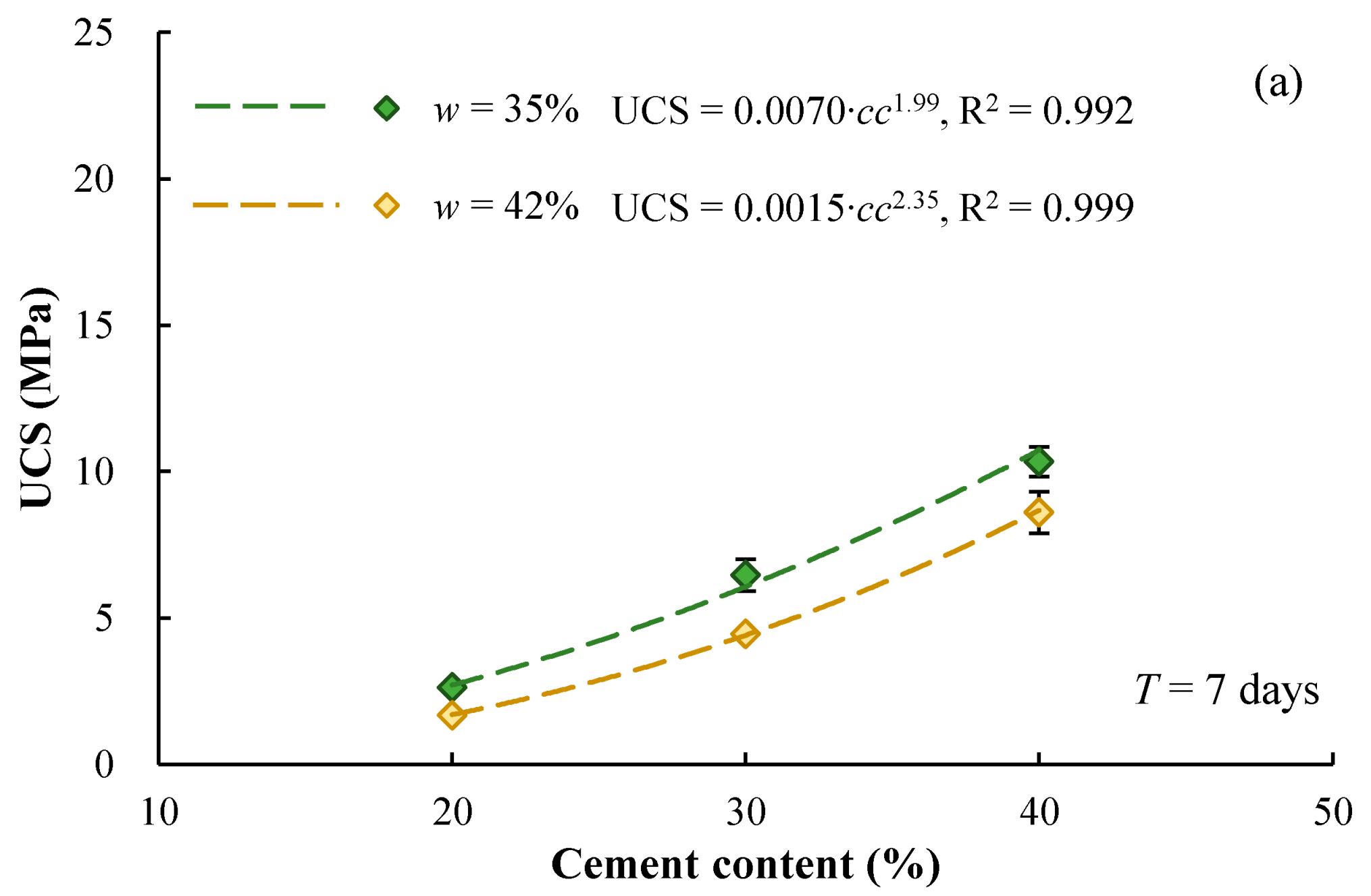
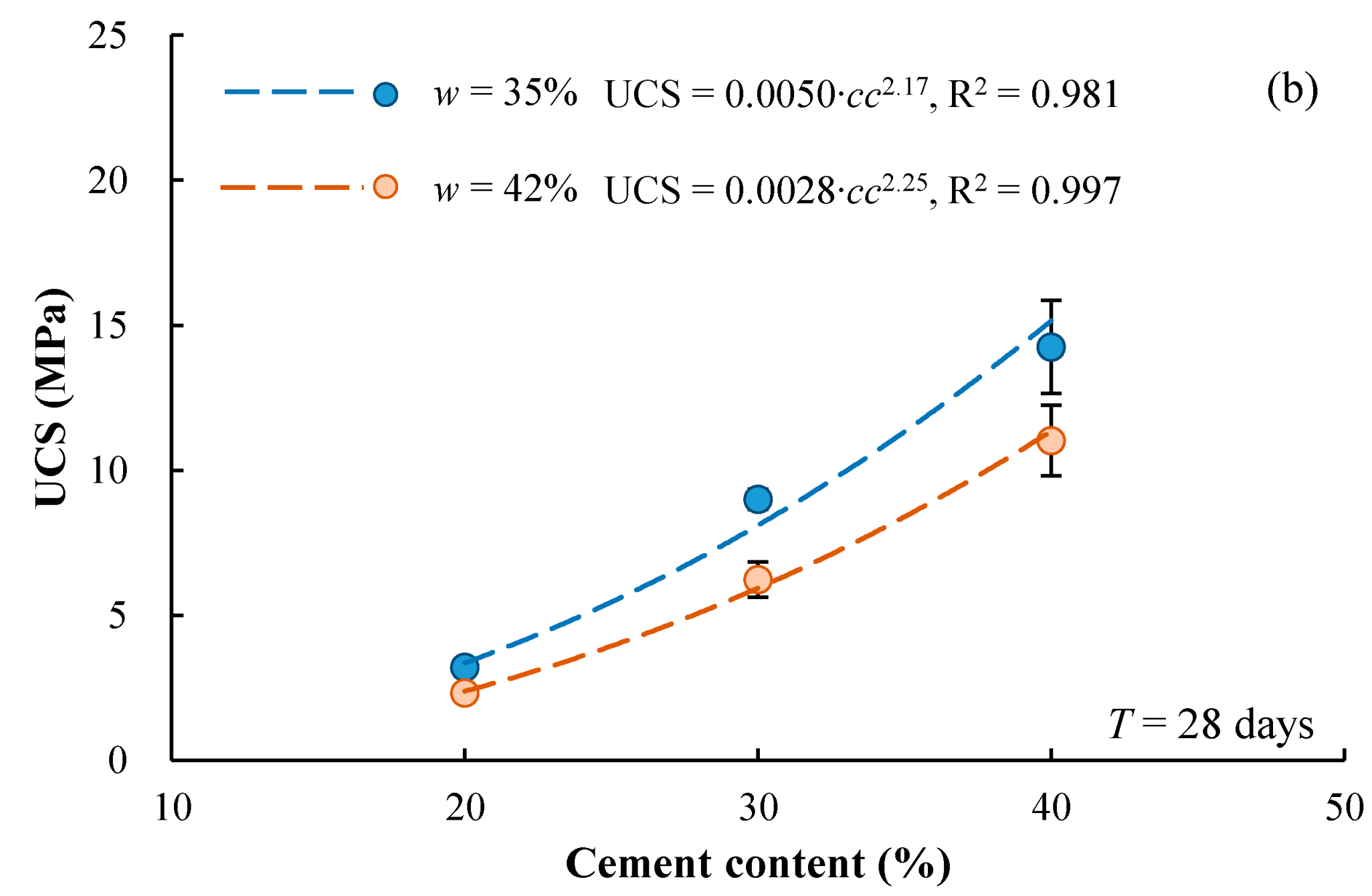
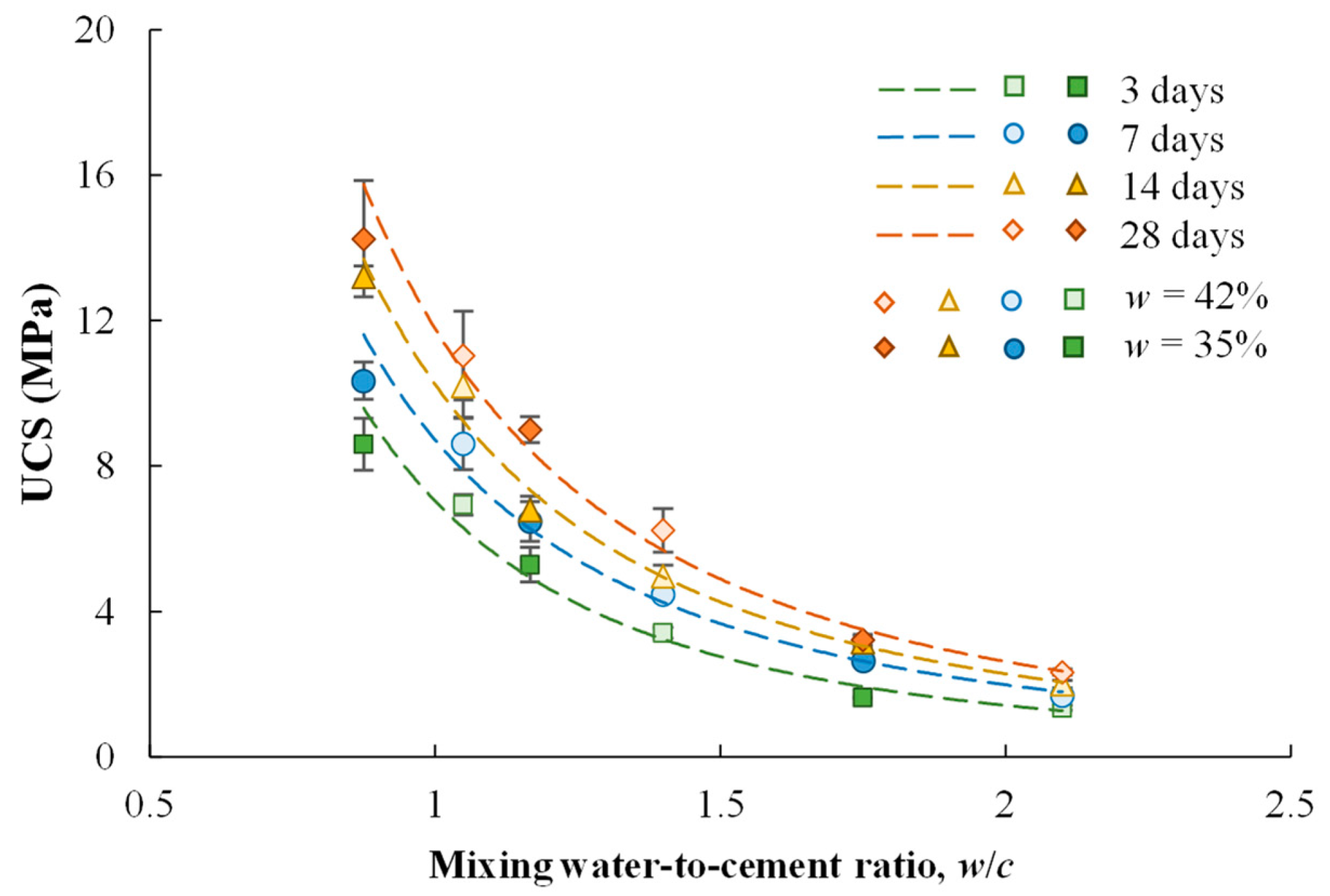
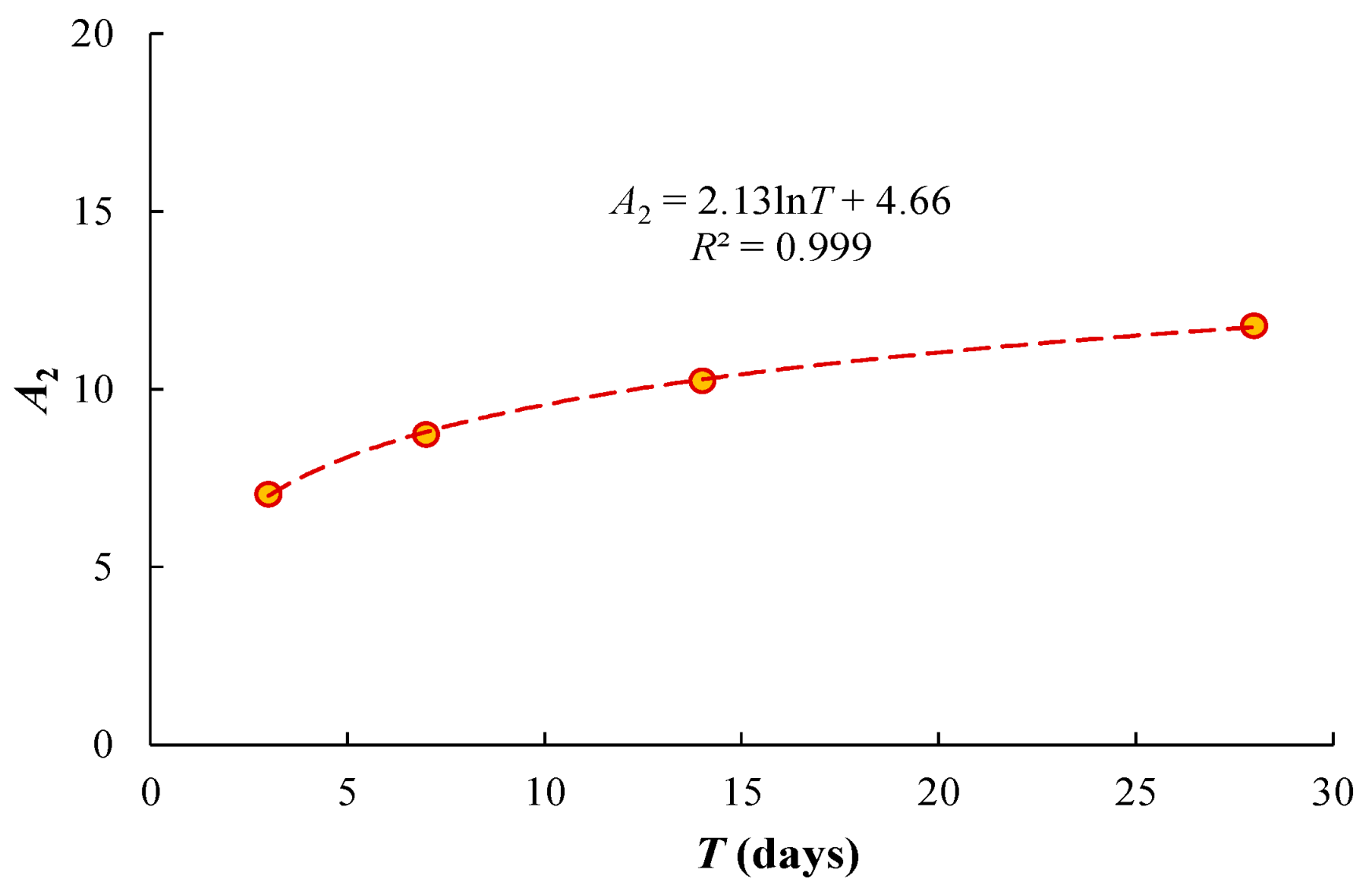




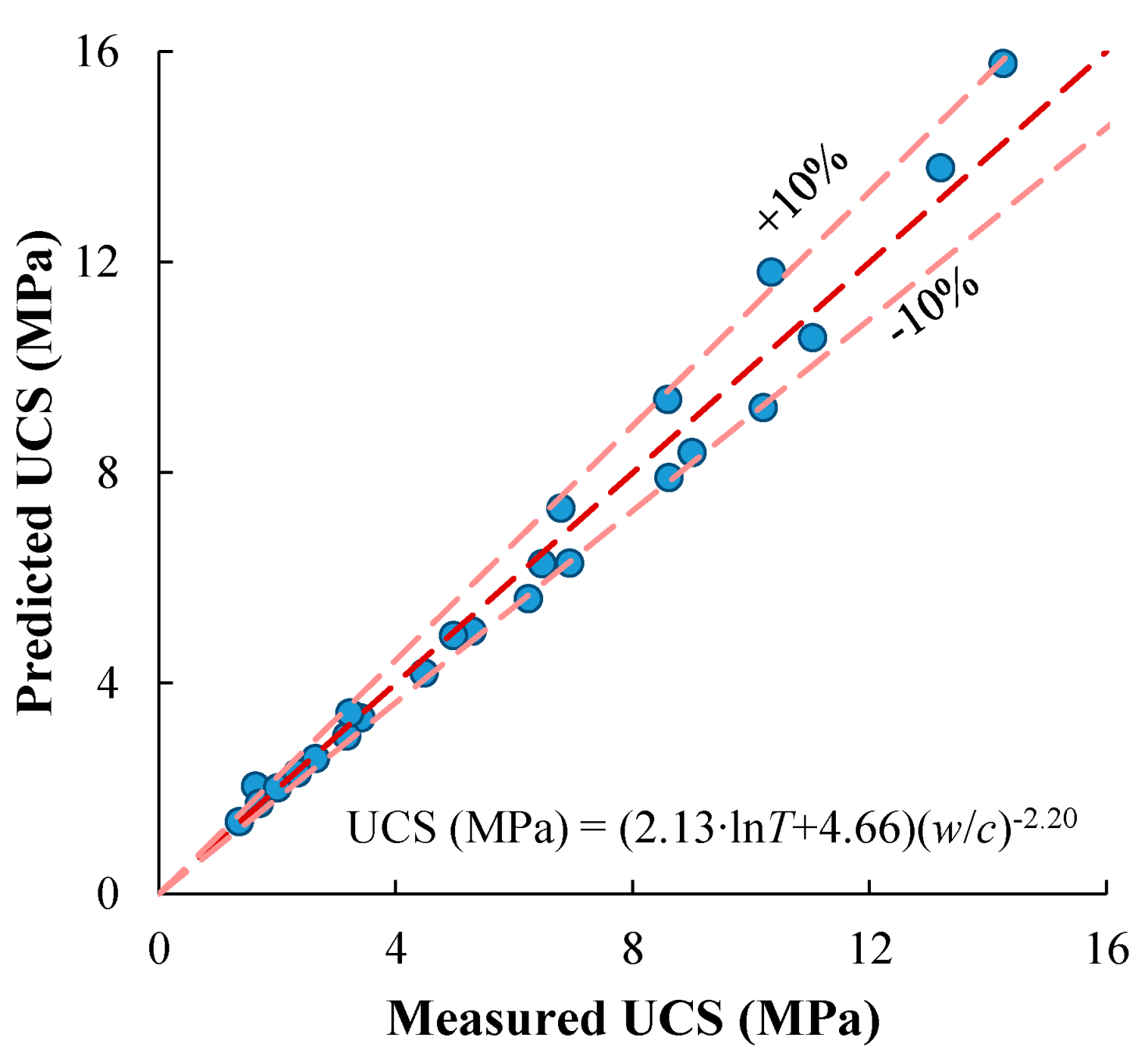
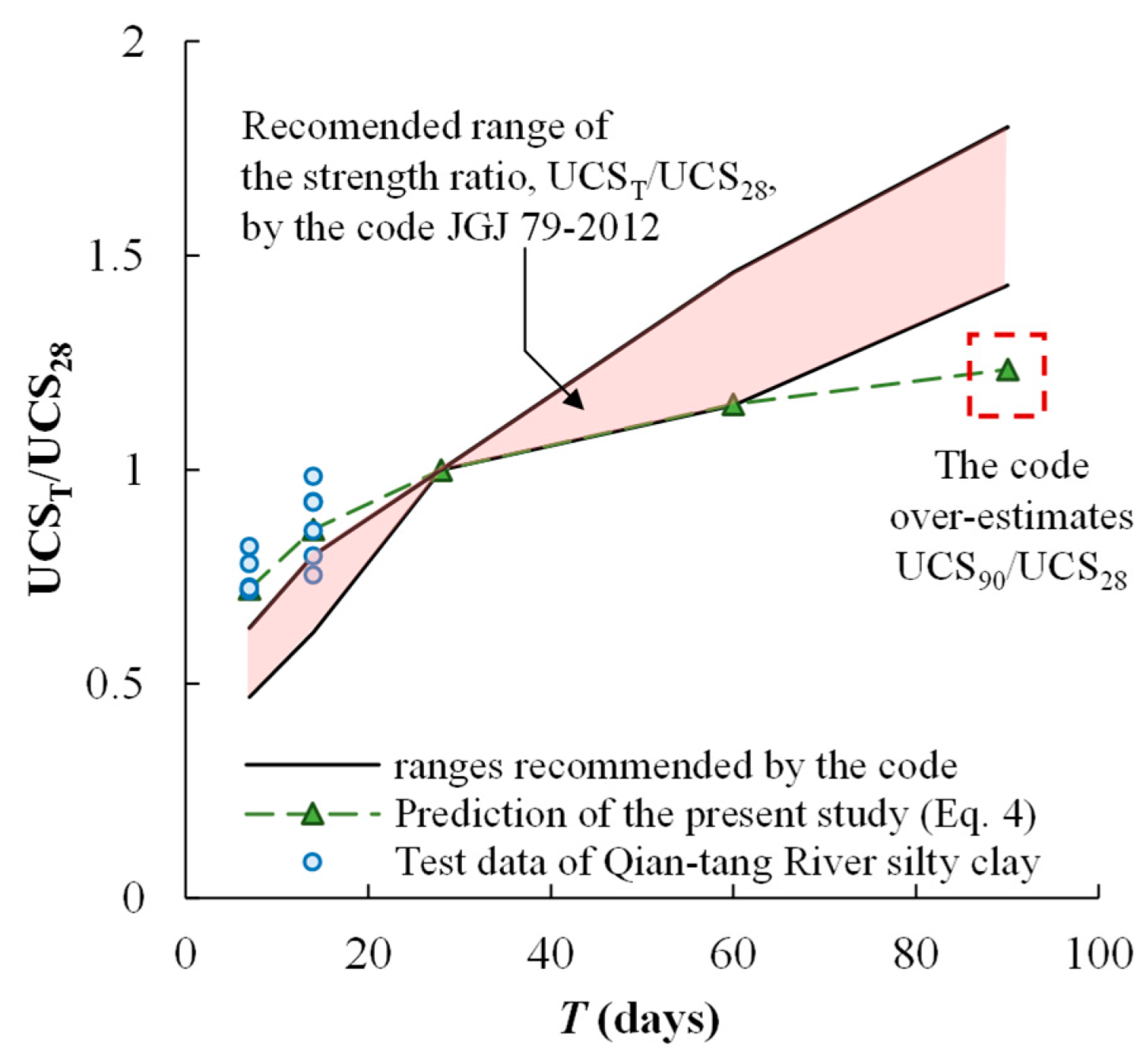
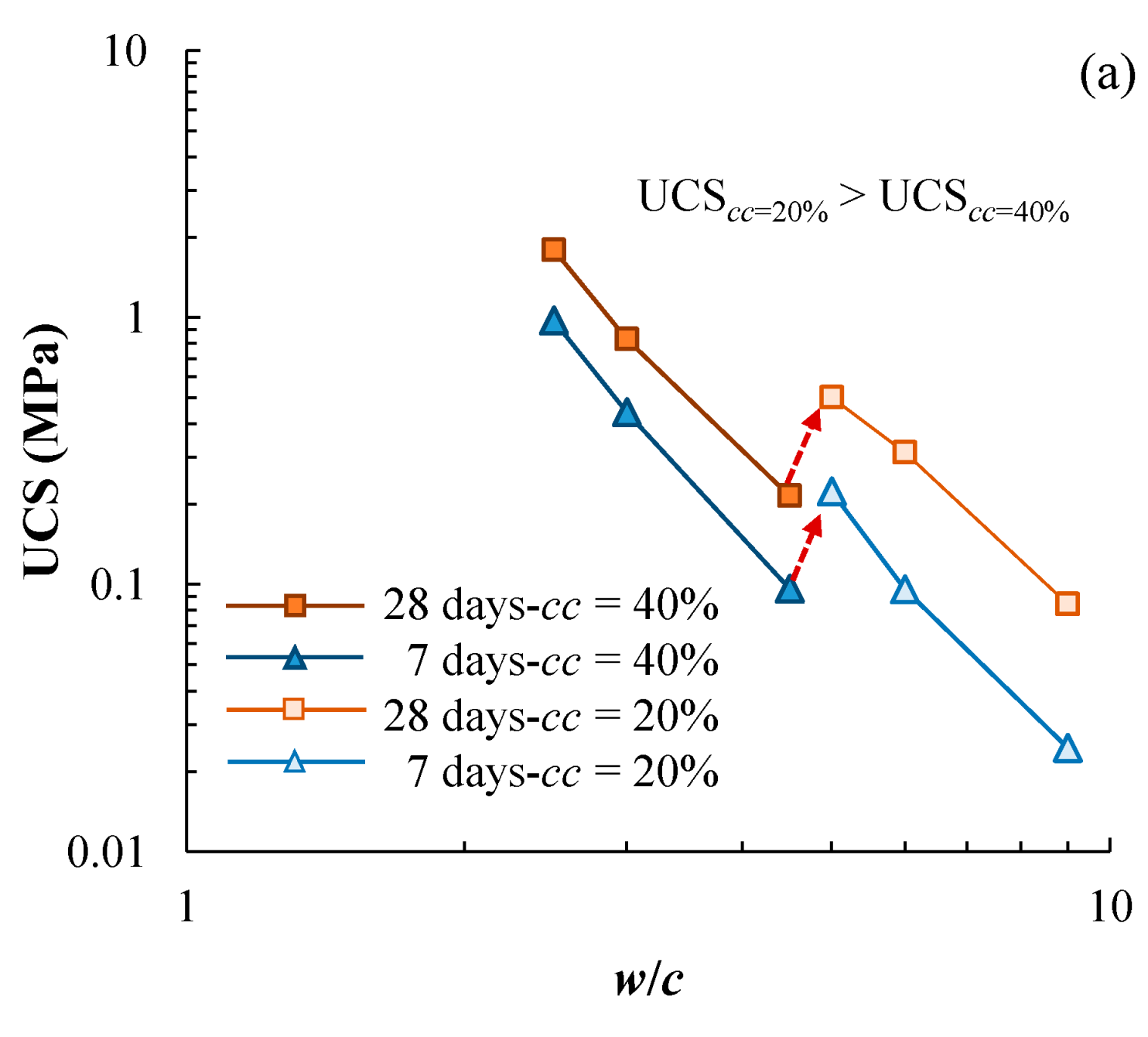
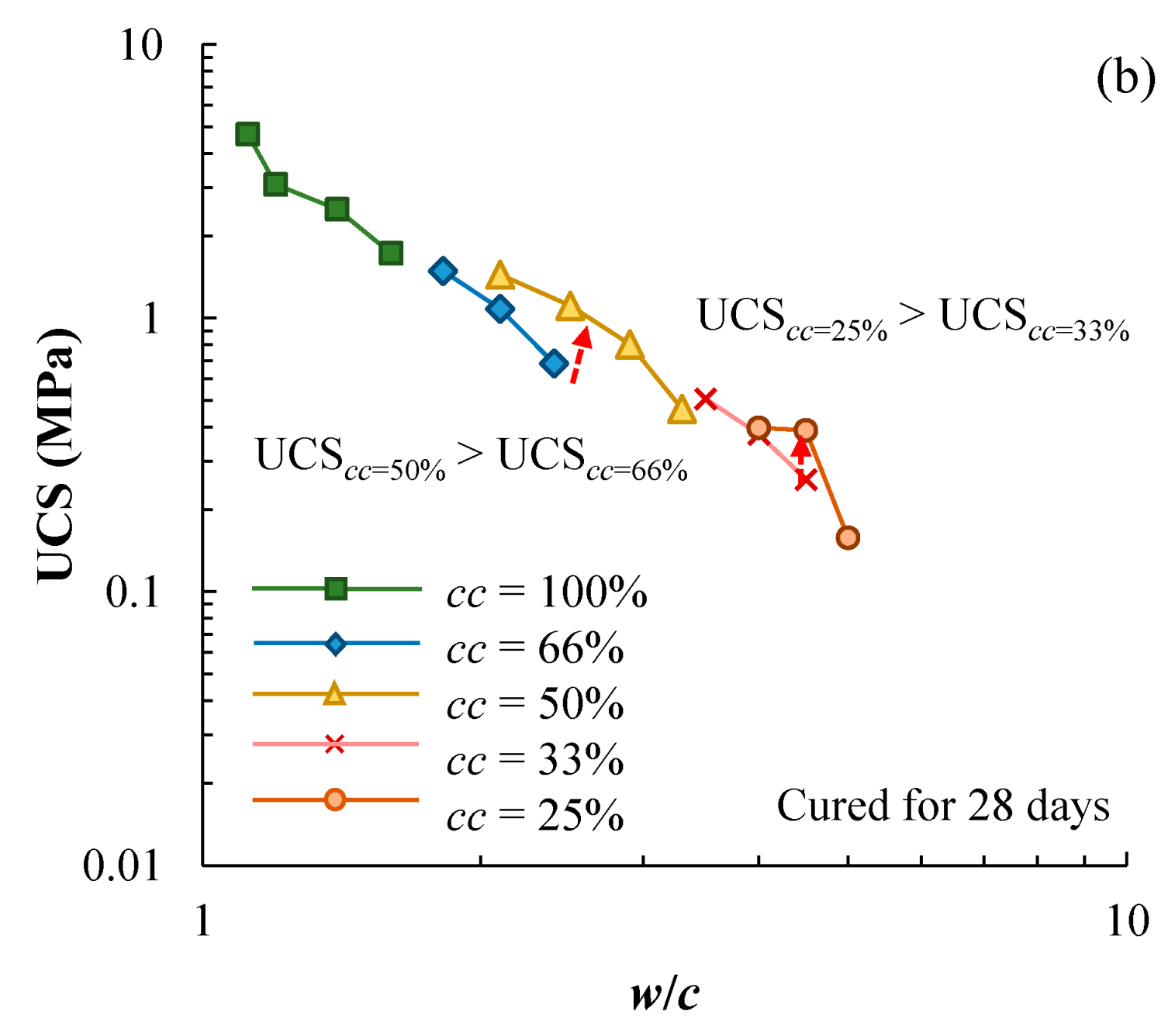
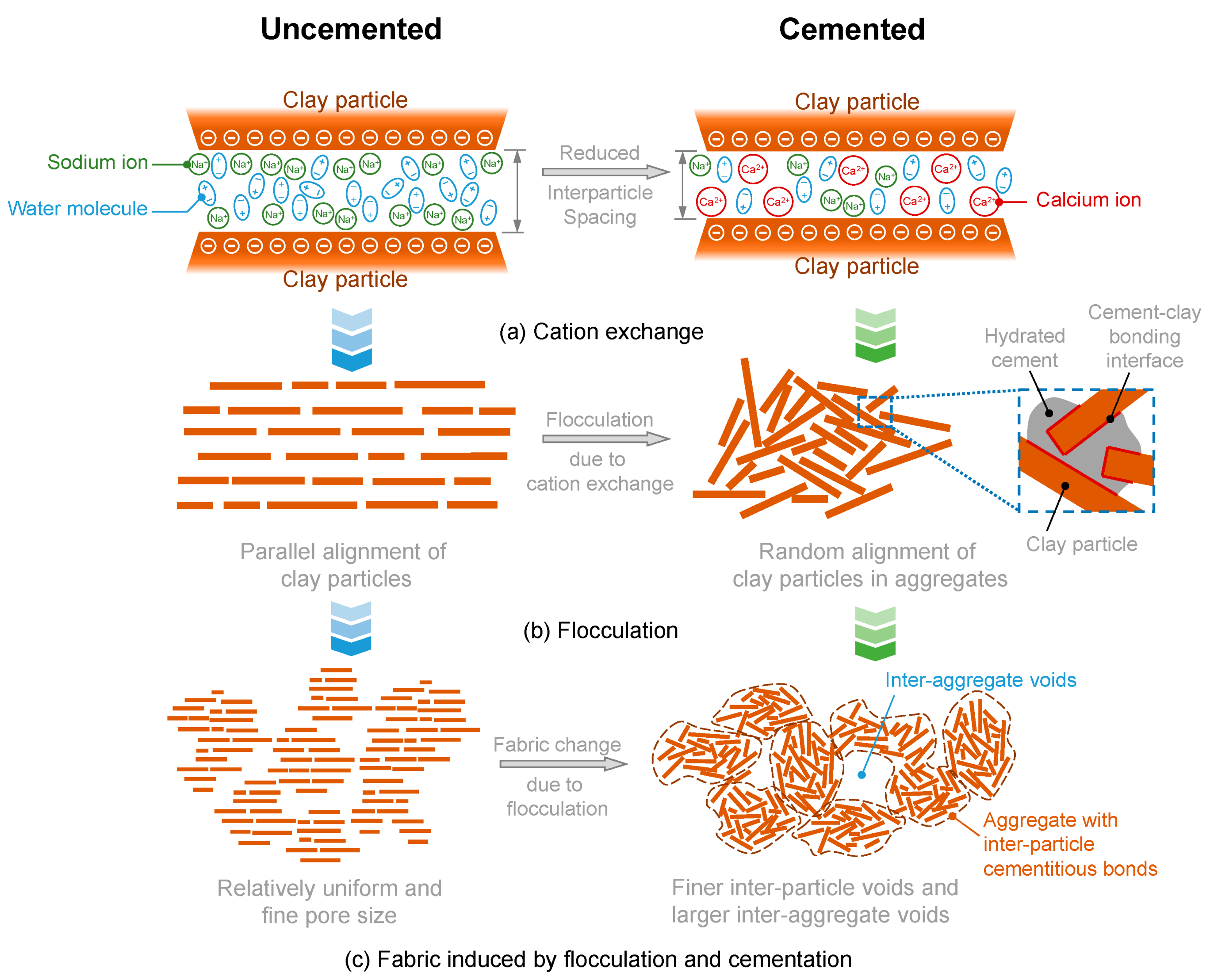
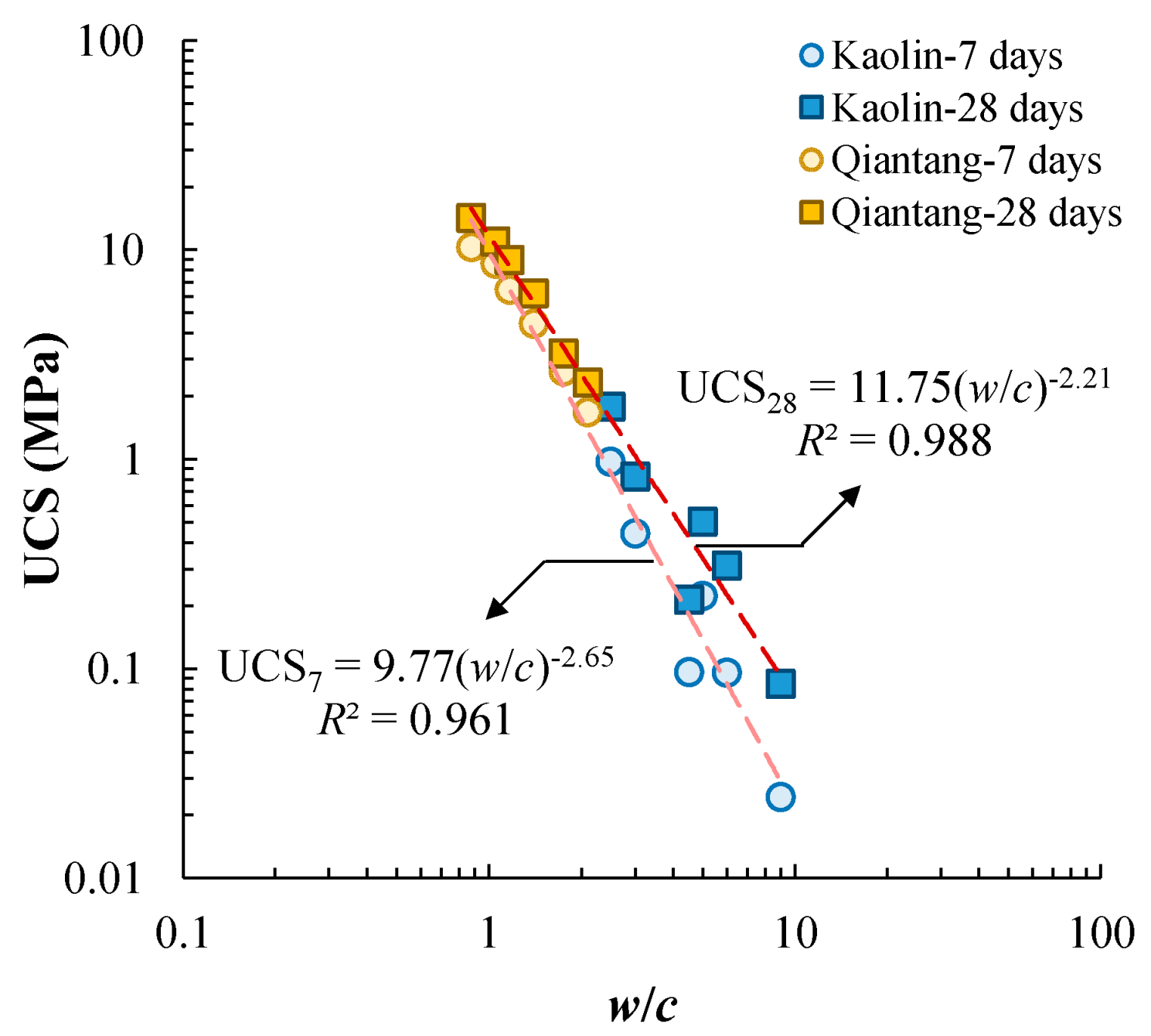
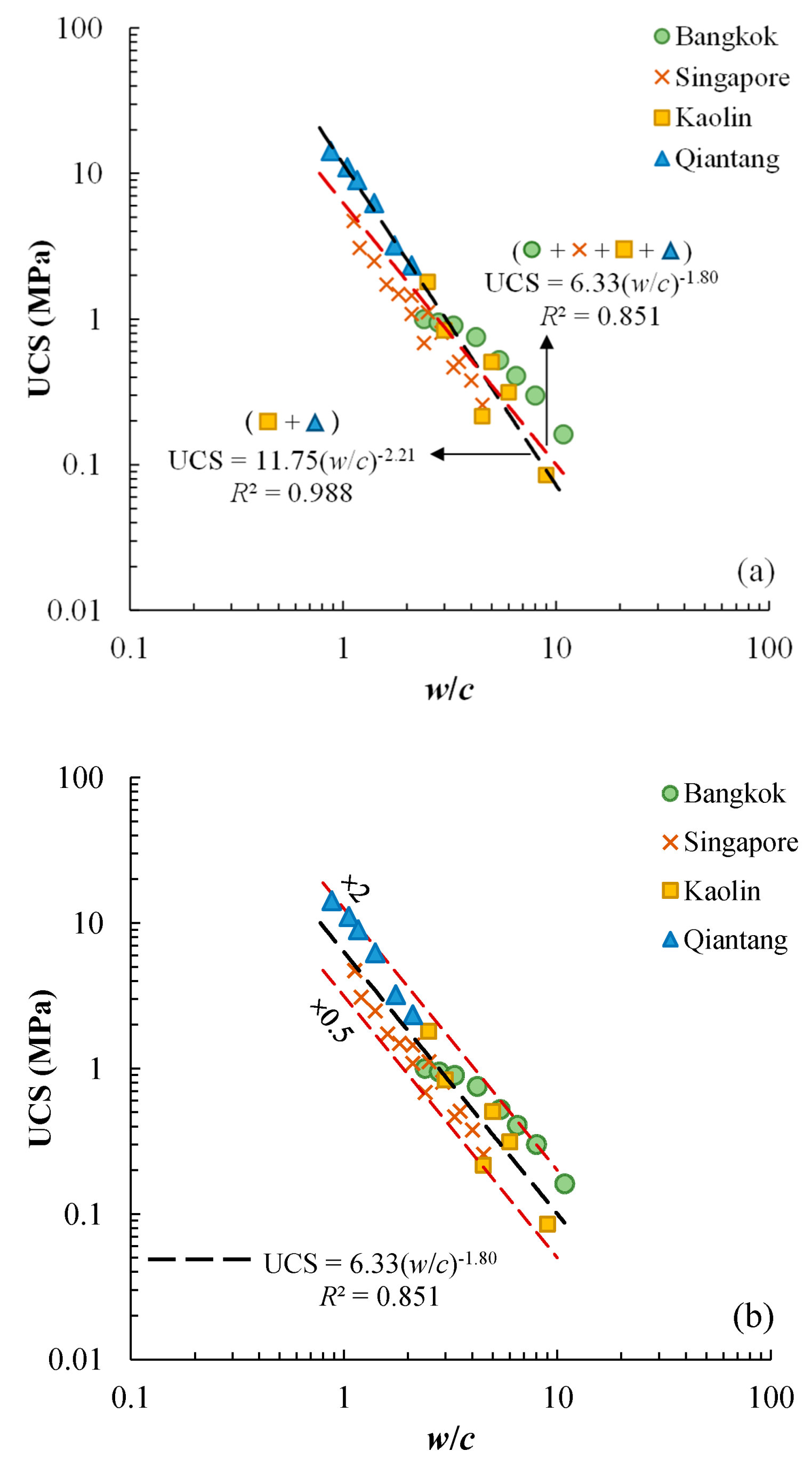
| Type of Soil | Liquid Limit wL (%) | Plastic Limit wP (%) | Plasticity Index Ip (%) | Soil Classification |
|---|---|---|---|---|
| Qiantang River silty clay | 33.1 | 16.2 | 17.0 | CL |
| Kaolin clay | 60.5 | 33.5 | 27.0 | CH |
| Mixing-Water Content w (%) | Cement Content cc (%) | Mixing-Water-to-Cement Ratio w/c | Curing Duration T (days) |
|---|---|---|---|
| 35 | 20 | 1.75 | 3, 7, 14, 28 |
| 35 | 30 | 1.17 | 3, 7, 14, 28 |
| 35 | 40 | 0.88 | 3, 7, 14, 28 |
| 42 | 20 | 2.10 | 3, 7, 14, 28 |
| 42 | 30 | 1.40 | 3, 7, 14, 28 |
| 42 | 40 | 1.05 | 3, 7, 14, 28 |
| Curing Duration, T (days) | Fitting Equation | A2 | B2 | R2 |
|---|---|---|---|---|
| 3 | UCS = 7.05∙(w/c)−2.31 | 7.05 | −2.31 | 0.990 |
| 7 | UCS = 8.73∙(w/c)−2.14 | 8.73 | −2.14 | 0.992 |
| 14 | UCS = 10.25∙(w/c)−2.17 | 10.25 | −2.17 | 0.974 |
| 28 | UCS = 11.79∙(w/c)−2.17 | 11.79 | −2.17 | 0.998 |
| Mixing-Water Content w (%) | Cement Content cc (%) | Fitting Equation | A3 | B3 | R2 |
|---|---|---|---|---|---|
| 35 | 20 | UCS = 0.73∙lnT + 1.02 | 0.73 | 1.02 | 0.889 |
| 35 | 30 | UCS = 1.54∙lnT + 3.42 | 1.54 | 3.42 | 0.900 |
| 35 | 40 | UCS = 2.68∙lnT + 5.56 | 2.68 | 5.56 | 0.972 |
| 42 | 20 | UCS = 0.44∙lnT + 0.85 | 0.44 | 0.85 | 0.998 |
| 42 | 30 | UCS = 1.21∙lnT + 2.04 | 1.21 | 2.04 | 0.976 |
| 42 | 40 | UCS = 1.88∙lnT + 4.94 | 1.88 | 4.94 | 0.988 |
Disclaimer/Publisher’s Note: The statements, opinions and data contained in all publications are solely those of the individual author(s) and contributor(s) and not of MDPI and/or the editor(s). MDPI and/or the editor(s) disclaim responsibility for any injury to people or property resulting from any ideas, methods, instructions or products referred to in the content. |
© 2024 by the authors. Licensee MDPI, Basel, Switzerland. This article is an open access article distributed under the terms and conditions of the Creative Commons Attribution (CC BY) license (https://creativecommons.org/licenses/by/4.0/).
Share and Cite
Zhang, L.; Li, Y.; Wei, X.; Liang, X.; Zhang, J.; Li, X. Unconfined Compressive Strength of Cement-Stabilized Qiantang River Silty Clay. Materials 2024, 17, 1082. https://doi.org/10.3390/ma17051082
Zhang L, Li Y, Wei X, Liang X, Zhang J, Li X. Unconfined Compressive Strength of Cement-Stabilized Qiantang River Silty Clay. Materials. 2024; 17(5):1082. https://doi.org/10.3390/ma17051082
Chicago/Turabian StyleZhang, Lisha, Yuan Li, Xiao Wei, Xin Liang, Jinhong Zhang, and Xuchen Li. 2024. "Unconfined Compressive Strength of Cement-Stabilized Qiantang River Silty Clay" Materials 17, no. 5: 1082. https://doi.org/10.3390/ma17051082
APA StyleZhang, L., Li, Y., Wei, X., Liang, X., Zhang, J., & Li, X. (2024). Unconfined Compressive Strength of Cement-Stabilized Qiantang River Silty Clay. Materials, 17(5), 1082. https://doi.org/10.3390/ma17051082






